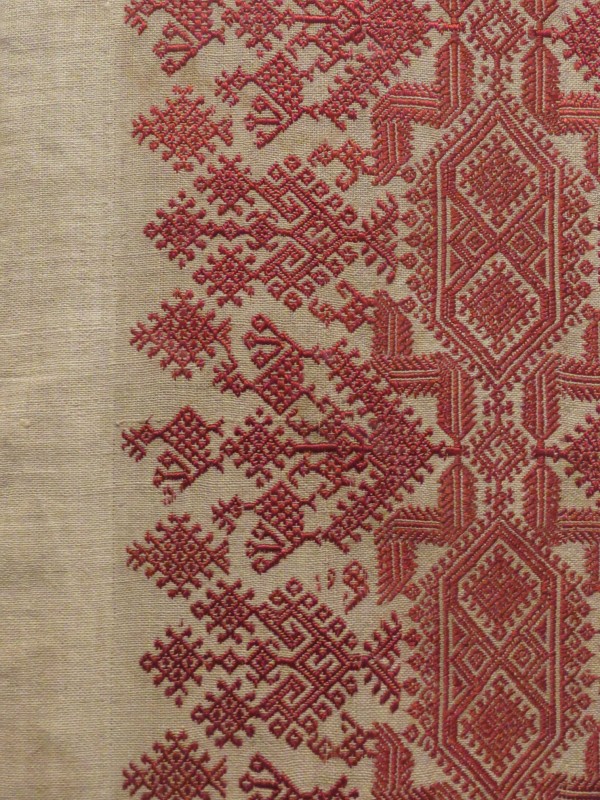The Richness of Greek Embroidery
When I think of “household embroideries,” I think of framed cross stitch samplers on the wall, or some pillowcases with daisy-stitched flowers with French knot centers. But last week I got to visit the Saint Louis Art Museum, and there I saw an exhibit showing how incredibly elaborate embroidery can be.
The exhibit featured household embroideries from the Greek Islands.
I was struck by the diversity of the styles, and by the lavish amount of stitching. If I had to grow my own fibers, spin my own threads and weave my own cloth, I just don’t think I could manage to decorate anything on top of all that.
This is a classic red and white design for a bed curtain panel from the 18th century, silk embroidered on linen. Its catalog page with all the details is here.
This is from a similar panel, with evenly spaced motifs. More information is here.
Totally different than the red-and-white scheme were some towels in vibrant pastels and metallic yarns. They were laying flat in a case, and it was hard to get a picture without the shadow of my camera shading them, so here how the photo came out in reality —
— and here is a better representation with the magical help of Photoshop, to correct camera distortion and bring back the color.
While I was poring over the textiles, three women came through the gallery. It seemed that two of them already worked for the museum, and one was either coming to work there, or study there. They were telling her about all the textiles they had in the collection, and they stopped and looked at this towel. One said it was her favorite because of all the sparkly silver threads, and the new one said, “You’d think that they would have tarnished by now.” And the first one said, “They have, that is why they have those iridescent colors.”
I really wanted to say, “Take me with you! Let me listen in on all your textile conversations!” but I didn’t, I was a polite museum visitor. But I bring you this pearl of knowledge that you will not find elsewhere in any of the printed or online information about this show. 🙂
More information about this towel is found here.
This next one was just unbelievable in the amount of thread packed into the surface.
Here is its catalog page. It is from Ioannina, which is not an island, it is on the mainland, but I am very glad it was included. (There is another pillow cover almost exactly like this one, as well as more embroideries, at the Benaki Museum in Athens.)
One of the exhibition labels said that these were collected by Frank Cook (the grandson of travel entrepeneur Thomas Cook of England), and his wife Beatrice Lindell Cook. She was from St. Louis, and donated the collection. Looking around online, I saw that textiles from this collection were on also view in 1969, at the City Art Museum of Saint Louis as it was called then, and that most of them had been published in a 1935 book, Mediterranean and Near Eastern Embroideries from the Collection of Mrs. F. H. Cook. That 2-volume book with colored plates is still available from used book dealers, and for only $975 to $1500, you can have your own copy! (It looks like only 250 copies were published so I guess that is why it is pricey.)
Failing that, there is a little more information about the exhibit, Greek Island Embroideries, here [note from 2023: originally there was a lot of information online, but apparently after the exhibit ended, they took it down].
When I got home and checked through all of my textile books, the only information I could find about Greek household textiles was in 5000 Years of Textiles, edited by Jennifer Harris. That book has eight pages on Greek embroidery and it covers a wealth of information. (And it is usually available used for about $6.00.)
…embroidery was more commonly used there for decorating a large range of domestic textiles. Home in the islands was usually a single room separated into an area for cooking ad living, with another for sleeping. Privacy, such as it was, was achieved by curtains. These curtains and the coloured plates and copper utensils which were hung about the walls were the only decoration to be found in the house. The bed was the most important piece of furniture in the house; it was often the only permanent fixture and always occupied a dominate position, placed on a platform or in a niche and hidden behind a hanging.
A number of other articles were also decorated to match and accompany the bed furnishings — long valances that were stretched along the front of the bed, innumerable long bolster cushions and small, square cushion covers.
Embroidery in Greece was primarily a domestic craft and part of the daily household ritual. Every household had a loom, and both linen and cotton cloth were woven on it. Any surplus material was sold locally. All clothes were made at home and when they were decorated it was by embroidery. Silk was cultivated in many of the islands and was one of the most valuable commodities exported either as a raw material or knitted into stockings. It was this locally produced silk, dyed at home , that was used for embroidery and which gives Greek island work its richness and quality. Because such an expensive material as silk was used, special stitches were developed to ensure that as much silk as possible was visible on the outer surface.
— page 244, 246, 248
I loved the exuberance of the embroidery designs and how the motifs were arranged in the space, so I am glad I had the chance to view them in person.
The exhibition will only be open until May 28, 2018, but you can see all of SLAM’s online textile collection here.

























Were there special servents to do the embroidery or did the lady of the house and her maid do it? It’s wonder they had time to eat or sleep!
The exhibit said some areas did have professionals who made some objects, but most people lived in one room houses and did at least some of the needlework themselves.
What a great exhibit this must be! I wish I could see it. The idea that those were towels blows me away! Metallic thread on towels? So gorgeous . . .
And I didn’t show this in the photos, but they would have sets of bed curtains to make a bed tent, embroidered all over, ten panels, measuring 26 feet around the bottom. I would be dead and buried before I would get even one finished. 🙂
Wow! Thanks for sharing!
I notice that these embroidered pieces are over 200 years old. They seem to be in amazing condition. Did the exhibit note any patterns that were routinely used? And I can’t imagine that metallic thread towel was actually used as a functional towel – it’s way too beautiful, plus the thread would be scratchy.
I think Beatrice Lindell Cook collected them about 100 years ago, and the 1969 exhibit catalog talked about how well preserved they were. I guess being in proper storage for the last 100 years helped them. And really, the textiles I have that are natural dyed Turkey red or indigo have held their colors too.
The 5000 Years of Textiles book talks about the use of the broadleaf and spitha (spark) patterns being used over and over, and those would be in that red and white textile I put first in the post, but that book also mentions that island populations were very isolated and so they had wildly differing traditions from island to island. Conquerors came in and either squelched regional tradition in some areas, or influenced it to the point where it resembled the conquering culture, but in the islands, the people were able to remain a little more free.
And as far as that towel, I’m with you, I wouldn’t take it anywhere, but the label said that the women went to the common baths and that was one of their few social gathering places, so they would bring those with them. I guess like some people today will take their expensive phones to the pool. The decorated part was just on the ends so maybe the owner used it very gingerly??
Amazing, thanks for sharing – I did not know about Greek embroideries!
Me either! On the one hand, after a lifetime of being interested in textiles, I am ashamed I didn’t already know about them; on the other hand, it gives me something to look forward to, to learn about them and about other cultural textile specialties I’m not aware of yet! 🙂
Such incredible workmanship! It’s amazing that these were household linens. Really they are works of art. Thank you for sharing your photos 🙂
It was lovely to see them, and I’m so glad that my camera was able to focus clearly. So often there is something about museum glass that makes the pictures blurry, but this time everything worked! 🙂
So beautiful. I wish I could see them in person. THanks for sharing.
I’ve absolutely loved this, as you knew I would… Your photos are wonderful and gave us such a great close up. They brought back memories of my grandmother’s work, she was one of those who followed the process through from beginning to end. .. from the growing to spinning to dyeing to weaving to embroidering.. creating some of the prettiest pieces. Thank you, Gwen.
You are so welcome! From the minute I walked into that gallery, I knew you would like them, and it was fun to do a post with you in mind. But in doing a little background research, I learned so much! And I am so impressed that your grandmother made textiles like that, doing all the steps in the process!
I have included your blog in INTERESTING BLOGS in FRIDAY FOSSICKING at
https://thatmomentintime-crissouli.blogspot.com/2018/05/friday-fossicking-11th-may-2018.html
Thank you, Chris
Pingback: TextileTopia | Deep in the Heart of Textiles
Pingback: Creative Juice #190 | ARHtistic License
Pingback: The Hidden Narratives in Our Wardrobes